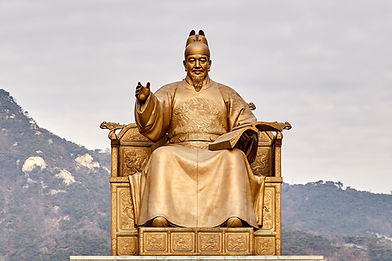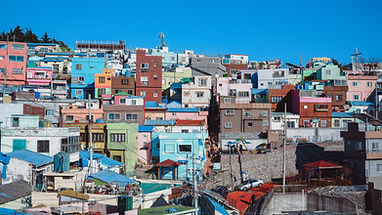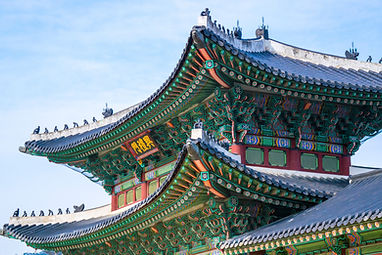South Korea

Welcome
Motto: "홍익인간"("弘益人間") "Benefit broadly in the human world /Devotion to the Welfare of Humanity"
Anthem: 애국가 Aegukga "The Patriotic Song"
South Korea is an East Asian nation located in the southern half of the Korean peninsula. The country is known for its green and hilly countryside dotted with cherry trees and centuries-old Buddhist temples, as well as its coastal fishing villages, its subtropical islands and its high-tech cities like Seoul, the capital.
Capital: Seoul.
Population: 51,709 million inhabitants.
Gross Domestic Product - GDP (PPP): $2.4 trillion.
Official languages: Korean.
Area: 100,363 km2.
Water (%): 0,3.
Currency: Korean Republic won (KRW).
Safety rating: Ranked 55 on the Global Peace Index with a score of 1.9.
Food
South Korea is a destination not to be missed if you want to discover a different aspect of Korean gastronomy: street-food. On most streets in South Korean cities, especially the streets of Seoul, there are always food stalls everywhere you can buy food. Indeed, it’s a great way to explore local flavors. It should be noted that it is during the evening that the street foods are in full swing. You can either eat while sitting in a tent, or roam the street with takeout food.
Food, like other aspects of Korean culture, combines both traditional Korean and international cuisine. Regarding Korean dishes, these are more or less spicy. Among those that I appreciated, and the best known:
Bi Bim Bap
A must in South Korea, especially if you visit the city of Jeongju where it originates. It is a mixture of rice, meat, sautéed vegetables, and an egg. the Korean barbecue, based on a hot plate system in the center of the table. They heat pieces of meat, and possibly side dishes like onion or mushrooms. The whole is accompanied by seasoned vegetables, more or less spicy. Bi bim bap, typical dish to eat during a trip to South Korea Bi bim bap, typical Korean dish Korean dishes are usually served with kimchi.
Galbi-jjim
A dish of steamed pieces of beef.
Yukhoe
Korean-style beef tartare, with small pieces of pear.
Kimchi
Kimchi is a piece of fermented vegetable (cabbage in general) and spicy. It is widely used in Korean cuisine, and we sometimes see in the villages this kimchi.
The tteokbokki
The tteokbokki is very popular in South Korea. It’s a tteok appetizer, a sticky rice cake in the shape of a stick. It is often accompanied by different ingredients according to your preferences: minced meat, hard-boiled eggs, vegetables, etc. Then, we bathe everything in a reddish spicy sauce with a few condiments such as chives and sesame seeds.
Korean sundea
For offal or blood sausage lovers, sundea is the food for you. You will surely find them in Korean street foods. It consists of cow or pork intestines mixed with various ingredients such as small vegetables, noodles, sticky rice or transparent vermicelli, all incorporated inside the casings of pigs or beef. The sausage is then cooked or boiled in steam. This dish is eaten at the same time as the tteokbokki.
The tornado potato
Tornado potato are fried potato skewers in a spiral shape, with a sausage in the center. For more flavor, you can dip the skewers in an aromatic assortment such as cheese powder or chili. It can also be eaten like a hot dog with ketchup and mustard.
The sannakji
Sannakji is a very popular Korean dish that is actually raw octopus simply seasoned with lemon juice. The octopus is especially one of the treasures of the sea in Korea. You will be amazed when the cook cuts the octopus, still moving, before your eyes. The sannakji is then served on a plate or in cardboard cups, decorated with a few salad leaves.
Korean dishes are also served more or less spicy, peppers being generally shelved in a dome. You are free to eat it or not ... Last point: as often in Asia, we eat with chopsticks. So if you are traveling with small children, bring your fork with you just in case.
Non alcoholic
All sodas and colas are present on the Korean market, but it is absolutely necessary to taste green tea from local production because it goes very well with all meals.
Alcoholic
Aside from beer, soju (sweet potato alcohol) is the most popular and least expensive of the alcoholic beverages. We recommend the distilled spirits made from fermented rice (cheongju) or plum (maeshliju), less harsh than the previous one. There is also a medicinal wine made from ginseng in the country, but, to be honest, we haven't tasted it.


Transportation
Plane
The major Korean cities are well served by national and international airlines. The largest airport in South Korea (and one of the largest in Asia) is located in Incheon, west of Seoul. It mainly serves domestic routes and destinations in East Asia, such as Japan, China or Taiwan. In addition, there are many small airports in the country which create a well-developed domestic air network. Ticket prices are generally reduced from Monday to Thursday due to the low number of passengers, to be higher on weekends and holidays.
Train
The South Korean rail network is highly developed and covers almost the entire country. Managed by the Korea National Railroad (KORAIL), it is renowned for its clean and comfortable trains. Today, many trains are equipped with a bar, wireless Internet access and a place to relax.
If you want to travel long distances over a short period, you can opt for the ''KR Pass'', which is offered at an advantageous price. Prices generally vary depending on the distance and the number of days covered.
Bus
Most cities in South Korea are linked to each other by thousands of buses operated by different regional companies. There are also long-distance buses serving small towns and villages in South Korea. Buses generally leave every 15 minutes from the main terminals. You can buy your ticket directly at the terminal or online.
Express buses connect major cities without stopping. However, over very long distances, the driver often stops for a ten-minute break at stops along the route. Note that express and intercity buses often use separate terminals. In addition, bus tickets are very affordable, but increase after 10 p.m., especially for luxury buses.
Ferry
Most of the Korean islands are linked together by a network of ferries operated by several companies. Ferries allow not only to travel from one island to another at affordable prices, but also to transport your car or motorcycle. The Korean ferry system not only covers domestic destinations, but also provides access to China or Japan.
Taxi
To take a taxi in South Korea, make sure the roof light is on and signal it. Each taxi has a counter which indicates the duration and the price of the journey. The prices are rather low and payment for the journey is made at the end of the journey, in cash or also by debit or credit card. Allow about 2,800 won for the first two kilometers.
There are two types of taxis in South Korea:
-
The ordinary taxi called "ilban",
-
The luxury taxi called “mobeom”, whose prices are higher.
If you are traveling on the highway, toll charges will be added to the rate. For rural routes, prices can be negotiated with the driver.
Rent a car
If you prefer to travel alone or with family, it may be wise to hire a car. To rent a car in South Korea, you must:
-
Be at least 21 years old,
-
Be in possession of a valid international driving license issued in your country of origin or a valid South Korean driving license
Rental rates usually start at around 60,000 won per day, but prices and discounts can be negotiated with the rental company. You will also need to purchase insurance from the rental company. Otherwise, you can hire a car with a driver.
Best things to do
South Korea is a country with a very rich past, so there are many cultural activities available to you. Here are some places not to be missed:
Old Seoul
First you need to spend at least a day visiting the historic center of Seoul to explore the old monuments. If you are passionate about history and ancient cultures, then 2 or 3 days of discovery on sites dating from the 1390s are even better!
Gyeongbokgung Palace
The Gyeongbokgung Palace and the National Folk Museum located on site will also take a day off your schedule. In fact, several cultural performances take place every day on the superb grounds of the palace. In spring, the visit is complimented by the many cherry blossom trees in full bloom. In addition, you will no doubt see several Korean women dressed in traditional “Hanbok” dresses. These traditional clothes are works of art in themselves, and Korean women wear them proudly. Then, if you want a cultural immersion, it is possible to rent the traditional dress for a few hours.
Unhyeongung Palace
You may also want to consider the Unhyeongung Palace. The rate of approximately 3,300 WON includes the rental of the traditional Hanbok for the duration of the visit to this former royal residence.
The Korean Folk Village is located near Suwong and Yongin, therefore on the outskirts of Seoul. The village offers a cultural immersion in the ancient Joseon dynasty. Then, if you are a lover of Korean television series, you will notice that many are filmed in the village.
A night in a temple? It's possible! You can live like a Buddhist monk, whether for one or more days.
The festive life of Seoul is an experience in itself! In fact, the city’s nightlife scene is considered one of the “best” and most popular in Asia.
Discover the traditional Korean arts and way of life at the Korea House in Seoul. Still in Seoul, indulge in the evening with national entertainment: karaoke. Get lost in the gardens and rooms of the legendary Gyeongbokgung Palace. Swap beer for a glass of soju, sweet potato alcohol. Contemplate the misty panorama from the top of Mount Seoraksan.


Best time to visit
Korea enjoys four distinct seasons and a variety of different climates. Located in the monsoon region of East Asia, the peninsula experiences hot, humid summers and long dry, cold winters. On average, temperatures are - 10 ° in winter and 30 to 35 ° in summer.
Rainfall is greatest in summer, June, July and August. They sometimes turn into typhoons. The air is then hot and humid, often heavy. You can easily swim. Spring and autumn are short, but very pleasant, because the air is fresh and the days often sunny. The east coast is the wettest. Cold and dry, winter begins in late November and lasts until early March. It is dominated by pleasant winds from Siberia, laden with dust. The south of the peninsula experiences less severe winters.
The best times to travel are the middle seasons, with a predilection for fall, especially between mid-September and late October (mild dry air, 14 ° C on average). Spring is quite mild (11 ° C), but the rains are frequent.
Winters are severe. However, the summers being hot and humid, T-shirts and bermudas are welcome. Do not forget what to cover during the chilly evenings of spring and autumn, as well as in places where air conditioning is omnipresent (restaurants, shopping centers, cars ...).
Quick tips
Internet
The vast majority of the South Korean population uses broadband. The prices depend, as in France, on the operator and the chosen package and on average the price is 35,000 won / month (or € 28). Many public places such as shopping centers, restaurants, metros etc ... have free and unlimited wifi. In some places, like bookstores, there is a charge."PC Bang" or "PC Room" are South Korea's cybercafes. The hour will cost you between 1 and 1.50 €.
Tips
Tipping is not mandatory but prohibited! In all circumstances (catering, hotel, luggage…) we do not give tips. It does not exist in South Korea and may offend the person providing you with service.
